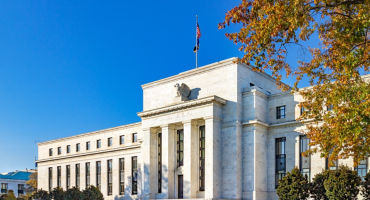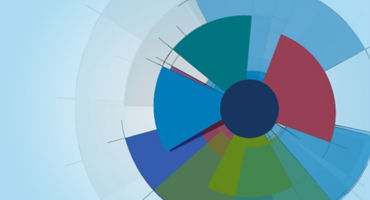- Fixed Income Analyst
Skip to main content
- Funds
- Insights
- Capabilities
- About Us
- My Account
The views expressed are those of the author at the time of writing. Other teams may hold different views and make different investment decisions. The value of your investment may become worth more or less than at the time of original investment. While any third-party data used is considered reliable, its accuracy is not guaranteed. For professional, institutional, or accredited investors only.
On December 18, the Federal Open Market Committee (FOMC) reduced its target range for the federal funds rate by 25 basis points (bps), to a range of 4.25% to 4.50%. Cleveland Fed President Beth Hammack dissented, preferring to hold the target range constant. The Committee added the language “extent and timing” to its consideration of potential changes in the target range. According to US Federal Reserve (Fed) Chair Jerome Powell, this language may suggest the need for caution regarding the pace of change from this point on.
The FOMC made no changes to balance-sheet policy and continues to reduce the Fed’s holdings of US Treasuries and mortgage-backed securities. Additionally, the Fed reduced the overnight reverse repurchase rate by 30 bps. In my view, this could signal the Committee’s commitment to extending quantitative tightening (QT) because the change is intended to support money market stability as reserve balances decline.
The Committee’s median expectation for the federal funds rate was unchanged for 2024 at 4.4%, but moved up 50 bps for year-end 2025 and 2026, to 3.9% and 3.4%, respectively. The median expectation for the target range also moved up, by 20 bps for 2027 and 10 bps in the longer run, to 3.1% and 3.0%, respectively. The change brings the summary of economic projections closer to market pricing, which had indicated 50 bps of cuts in 2025 prior to the meeting.
The FOMC’s median forecasts for personal consumption expenditures (PCE) and core PCE increased for 2024, 2025, and 2026. The Committee’s median forecast for core PCE in 2025 is now 2.5%, well above the Fed’s 2% target. I believe risks to inflation are to the upside in 2025; although inflation is off its peaks, disinflation appears to be stalling. Importantly, the sources of inflation have grown more diversified in recent months. Earlier this year, shelter was the primary source of overall inflation, but, in recent prints, shelter inflation has converged toward services inflation overall. Additionally, previous sources of disinflation, such as goods and food, have contributed to price increases.
The Committee’s median forecasts for unemployment in 2024 and 2025 came down 20 bps and 10 bps, to 4.2% and 4.3%, respectively. Meanwhile, the median forecast for unemployment in 2027 moved up 10 bps, to 4.3%. My view is that the risks to the labor market are to the downside, but some of the largest risks appear to have abated for now. For example, job openings and quit rates declined this year, but no longer appear to be rapidly falling. Similarly, the pace of decline in wages appears to have troughed in recent months.
The FOMC’s median forecasts for real GDP moved up 50 bps for 2024, to 2.5%, up 10 bps for 2025, to 2.1%, and down 10 bps for 2027, to 1.9%. Most economic data in the US is consistent with continued strength, and financial conditions have generally improved since the US election, as risk assets have outperformed.
I am generally constructive on growth, though I remain watchful of the incredibly anemic housing market and think valuations on risk assets may be stretched. Like the FOMC, I am attentive to the risks of pulling growth forward, as fiscal outlays and inventory appear to have picked up going into year-end.
During his press conference, Chair Powell described the delivered interest-rate cut as a “close call,” which was surprising rhetoric because the cut was fully priced into markets before the meeting. He indicated that policy is “meaningfully restrictive” at these levels, and that future hikes are unlikely. However, he noted his belief that policy is “significantly closer to neutral” than it was at the beginning of the cutting cycle.
Chair Powell reiterated that inflation is “still broadly on track.” In explaining this view, he pointed to disinflation in shelter (in the November CPI print, shelter came in at 0.3% month over month, with owners’ equivalent rent at 0.2% month over month). He also noted that other sources of inflation, including some components of services, tend not to portend future inflation.
In characterizing the labor market, Chair Powell explained that he believes the labor market is cooler than it was in 2019 and still cooling, though the largest downside risks to labor appear to have abated. He attributed his “solid” characterization of the labor market to low job-finding and low layoff rates.
In order for the Fed to deliver on its rate-cut projections, labor market moderation will need to persist, and inflation outside of owners’ equivalent rent to moderate.
Expert

Financing the AI boom: credit markets at a crossroads
Continue readingFinding durable value amid shifting currents
Continue readingURL References
Related Insights
Stay up to date with the latest market insights and our point of view.

Weekly Market Update
What do you need to know about the markets this week? Tune in to Paul Skinner's weekly market update for the lowdown on where the markets are and what investors should keep their eye on this week.

FOMC: Easing into uncertainty
Fixed Income Portfolio Manager Jeremy Forster profiles the Fed's December rate cut, labor market trends, inflation pressures, and the role of anticipated changes to FOMC leaders in 2026.

Opportunity ahead: Optimism or illusion?
Explore our latest views on risks and opportunities across global capital markets.

Financing the AI boom: credit markets at a crossroads
Fixed Income Portfolio Manager Derek Hynes and Fixed Income Investment Specialist Will Prentis examine how the AI financing boom is transforming credit markets and discuss the opportunities and risks it creates for investors.

Low tide, sharp eyes: What to pick up
Fixed Income Managers Campe Goodman and Rob Burn share their outlook for credit in 2026 and discuss how investors can reposition for an environment where opportunities are harder to find.

Finding durable value amid shifting currents
Fixed Income Strategist Amar Reganti and Investment Director Marco Giordano explore how to approach bond investing in 2026. They see durable value for investors who can flexibly adjust to the shifting currents ahead.

Monthly Market Review — October 2025
A monthly update on equity, fixed income, currency, and commodity markets.

Investing in 2026: prepare for inflationary growth
Macro Strategists John Butler and Eoin O'Callaghan share their annual macro outlook and discuss likely implications for markets and investors. They outline four potential scenarios graded by level of probability.

Rapid Fire Questions with Ross Dilkes
In this edition of “Rapid Fire Questions,” fixed income portfolio manager Ross Dilkes shares his views on the Asia credit market—covering the macro outlook, China’s momentum, the most compelling opportunities across the region, and key risks shaping the next 12 months.

Constructive, selective, resilient
Amar Reganti, a member of our Insurance team, explains why he believes insurers should remain selectively risk-on while prioritizing high-quality income and preserving flexibility to add risk as valuations improve.

Questioning US credit quality
Fixed income strategist Amar Reganti examines questions surrounding US creditworthiness.
URL References
Related Insights
Monthly Market Review — October 2025
Continue readingBy